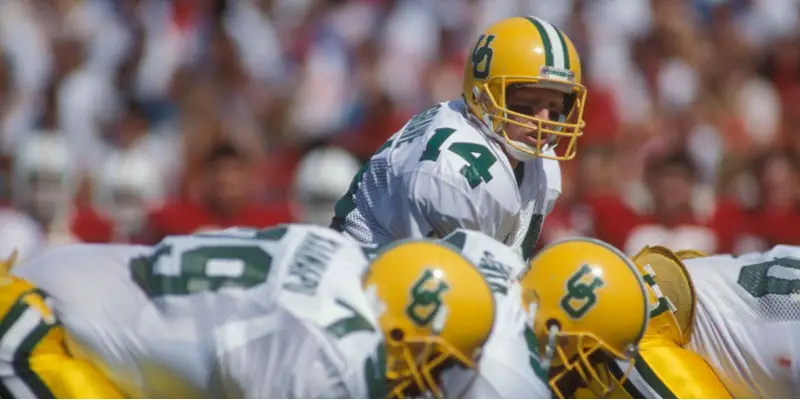
Bill Musgrave and the Oregon Offense.
As the Ducks transition this week from a victory over Washington State to prepping for Washington, I’ve found myself thinking back to two pairs of star players from Rich Brook’s 1980s squads, each part of upset victories over these Northwest rivals.
Many Duck fans remember Washington State running back Reuben Mayes’ NCAA record-breaking 357 yards at Autzen Stadium in 1984, as the Cougars won 50-41. (In last week’s Register-Guard, columnist George Schroeder caught up with Mayes, who is now, as it happens, living in Eugene and a self-described Duck fan.) But Oregon also had a talented tailback named Tony Cherry, who helped the team earn its revenge the following season.
With a then-rare nationwide cable TV audience watching on TBS, the Ducks opened the season on the road in Pullman against not only Mayes, but the much ballyhooed “RPM” of Cougs trio that also included quarterback Mark Rypien and receiver Kerry Porter. Rypien would go on to win a Super Bowl as starter for the Washington Redskins in 1991. But the game turned out to be a coming out party for Cherry, an undersized but quick and powerful junior college transfer—a forerunner of Jacquizz Rogers, one might say—who had joined the team a year earlier but struggled at first to find his place.
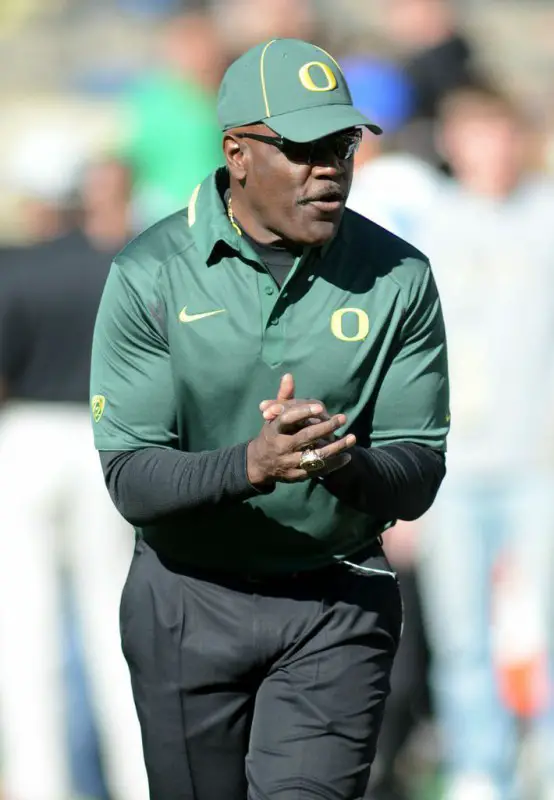
Coaches such as Gary Campbell have laid the foundation for the program
“I had a verbal offer from USC, but they wanted me to be just a kick returner because of my size. I was like, ‘I don’t think so,'” he said in an interview last year for my book, Tales From the Oregon Ducks Sideline. “Oregon brought me in as a flanker. They also didn’t want me to play running back. They’d been running the veer offense, and I’d run it well in junior college at UC Riverside. But as soon as I got there, the coach who recruited me was gone, and there was a brand new offense—no more veer. But it was all good, because that’s when [running backs coach] Gary Campbell and [offensive coordinator] Bob Toledo came in with a pro-style offense. Coach Campbell noticed me and said, ‘You’re a running back.'”
In 1984, Cherry split time with fellow running back Kevin Wilhite while earning all-conference honors as a kick returner.
He credits his time in a practice group called the “Slug Patrol” for allowing Cherry to elevate his game in 1985. “That was a program Coach Brooks had for players who came into camp out of shape,” he remembers. “I was kind of relaxed and having a good time in the summer. So they said, ‘you’ve got a practice after practice—the slug patrol.’ That was the best thing for me. But I’ll tell you: when I hit that field against Washington state, it was nothing compared to the slug patrol. I was just waiting to burst.”
And against the Cougs, he did, gaining 143 yards on 34 carries. “That ended up being my favorite game I ever played in.” That says a lot, because that season Cherry would go on to gain a record 1500 all-purpose yards, including 227 yards against Stanford.
Yet Cherry’s teammate, receiver Lew Barnes, was even more electrifying. He had come to Oregon after other Pac-10 teams passed him up because, like Cherry, Barnes was undersized. But in 1985 he became a first-team All American as part of a potent tandem with Ducks quarterback Chris Miller. That year Barnes would wind up with 50 receptions for 789 yards, the most by any Oregon receiver in the 1980s and the third-best in Ducks history at the time.
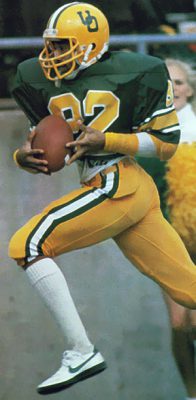
Lew Barnes 1983
More than just the yards he accrued, Barnes was one of those special players who seemed capable of magic every time the ball touched his hands, not unlike De’Anthony Thomas this season. That’s why it so shocked me when, during our interview last year for my book, Barnes asked if I could help him get a a video copy of him playing at Oregon.
Now a high school coach in California, Barnes said his players would sometimes jokingly refuse to believe that he had once been a star for the Ducks; and in these days, of course, YouTube clips and ubiquitous highlights were not commonplace. I was astonished. This was a player who’s autograph I had counted among my prize possessions for more than 25 years.
Could you imagine some day if your children or grandchildren denied the existence of, say, De’Anthony Thomas or LaMichael James? There was a reason, after all, why more than any other player of the early 1980s, fans made a point of calling his first name, making Autzen Stadium one giant serenade: “Leeeewwww!”
“It gave me chills when I heard that,” he remembered.
Given how the Ducks became a perennially bowl-bound program a few years after Barnes’s graduation, in retrospect his teams with Miller, Cherry and Brooks in 1984 and ’85 were ones in which the talent finally began to come together, even if the team didn’t quite possess the depth and consistency to churn out wins.
“Injuries played a huge part of it,” Barnes said. “We suffered some pretty significant ones on defense in both of those years. When you have any type of injury in any program, there’s usually a huge deficiency when you go from a starter to the second string. It makes an impact how much depth you have on your team. When I got there, Oregon was just getting off of probation. I’m sure that had an impact on their ability to acquire strong backup talent. But we still had guys going into the NFL almost every year. We had good talent.”
Meanwhile, as Chip Kelly’s current Ducks squad prepares to take on an increasingly dangerous Washington team this Saturday, another pair of Brooks-era players—Bill Musgrave and Terry Obee—come to mind with their leading roles in Oregon’s back-to-back wins over the Huskies in 1987 and ’88, which at the time were earth-shattering moments of nirvana for long suffering Duck fans.
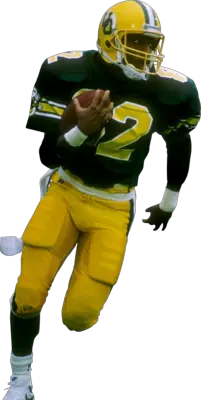
Terry Obee
When Oregon beat Washington 29-22 at Autzen on October 3rd, 1987, it was the first Ducks victory in the series since 1980, and only the second since 1973. When the game began, as was custom in those days, the end-zone sides of the field were a sea of purple, with Washington bringing a caravan of thousands of confident fans. The Huskies came into the game undefeated, with quarterback Chris Chandler (who in 1998 guided the Atlanta Falcons to the Super Bowl) the subject of a mounting Heisman Trophy campaign.
But the Ducks of 1987 were not exactly slouches. Going into the game Brooks’s team was 2-1, its only loss a respectable 24-14 at Ohio State. Quarterback Bill Musgrave was just a freshman, but he had already guided the team to an impressive road win at Colorado in his debut. But this game was really Musgrave’s first landmark victory.
After Washington took the early 7-0 lead in that game, the young quarterback hit sophomore Terry Obee on a screen pass at Oregon’s 18 yard line, and an apparent error in coverage by the Huskies meant that there was no one in front of him, allowing Obee to scamper 82 yards to the goal line. It was more than a case of tying the game. As Autzen Stadium announcer Don Essig said to the crowd, “82 yards in one play,” the Oregon faithful roared not just with excitement over the touchdown, but the sense that the Ducks really were capable of matching the punches thrown by this proud, multiple Rose Bowl-winning Goliath of a program under head coach Don James—that they could compete in and win the game.
In the game before, “We had to put together a 90-yard two-minute drive into the wind to beat San Diego State,” Musgrave said to me in an interview for Tales From the Oregon Ducks Sideline, “Which gave us even more confidence going into the Washington and USC games. The stars were aligned. We were a young team gaining confidence and we hit a couple big plays. We kind of got on a roll. There’s a lot to be said for a young team trying to find its identity, and that’s what we were at that time.”
When I talked to Musgrave about the Washington game, he was eager to rattle off the names of countless teammates. “We had some senior leadership on the offensive line,” he recalled. “They were awfully patient with me and took me under their wing, especially Jeff Stefonic, our big tackle, #69. And then the center at that time was Gary Gilbert, who was a 205-pound character when he showed up out of high school and maybe got to 258 at the very most. He allowed me to room with him during the summer when I was getting prepared for that freshman season and fall camp.
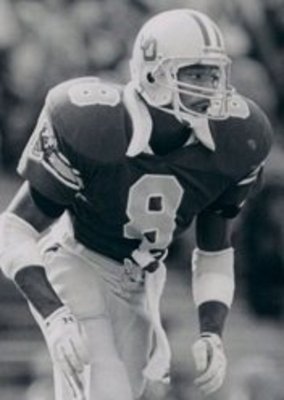
Anthony Newman recorded 247 tackles in 3 seasons as a Duck
He was really my go-to guy in terms of when I needed guidance. The skill positions were great, of course. Derrick Loville, it was his second year, because he had played as a true freshman. Latin Berry was in the backfield, and Randy Wilhite and Dwayne Harper our JC transfer, #33. The senior tight end was Tim Parker. The receivers were young: Tony Hargain and Terry Obee. But we also had JJ Birden. We had great leadership on defense. Matt Brock was a junior and Rolin Putzier was playing nose. Of course we had Anthony Newman over there.”
The week after the 29-22 Washington win, Oregon continued its wild ride with an equally dramatic and cathartic 34-27 victory over USC, another team whose quarterback (Rodney Peete) was seen as a Heisman candidate. But as would happen in both of his first two years, Musgrave and numerous other key Ducks succumbed to injury and the team’s 4-1 start gave way to a four-game losing streak. Musgrave was back for the Civil War in 1987, a 44-0 drubbing of Oregon State, which helped to secure a 6-5 season, the Ducks’ first winning campaign in three years—although not enough in those days to bring a bowl game.
When Oregon faced Washington the next year, the Ducks had gained confidence and boasted a 5-1 record. In a rare twist of scheduling, the game was at Autzen for a second year in a row. And it was even closer than the seven-point game the season prior. As is now branded on the brain of any longtime Ducks fan, it was a risky end-around play to Terry Obee that shocked the Huskies and gave Rich Brooks’s team a come from behind victory.
“We had a fantastic defense,” recalled Musgrave, who now serves as the Minnesota Vikings’ offensive coordinator. “And on offense we had matured from the year before. I don’t think it’d be any stretch to say that was the best team I was on in my four years at Oregon. We were 5-1 and on our way to 6-1.
Musgrave was coming into his own in a big way as a sophomore, which this game only confirmed even if it was Obee who scored the famous winning play. He credits offensive coordinator Bob Toledo along with Brooks. “Coach Toledo was so knowledgeable about Xs and Os. He had coached defense for a number of years at USC, he had been a head coach. I was fortunate to really learn the game from him,” Musgrave said. “He spent innumerable hours with me up in his office at Mac Court teaching me about not only offense but defense: where coverages were susceptible to certain patterns and so forth. Really the lessons that he taught me at that time I apply every single day in my profession as a coach. I was really fortunate to be exposed to him.”
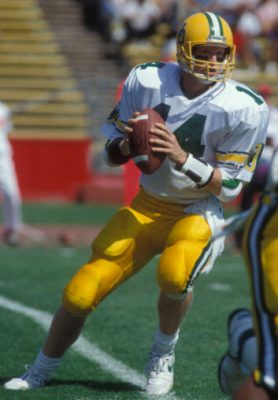
Bill Musgrave
But the Washington game had been tough for the young sophomore, particularly their massive All-American defensive lineman, Dennis Brown. “I think I only completed about 10 balls in that game. It’s probably the worst completion percentage I ever had in my life. But we battled tooth and nail and got close to the goal line,” Musgrave remembers. “I remember a timeout being called, and I went over to the sideline, and Coach Toledo and Coach Brooks had been discussing I’m sure for a number of minutes what the play call would be.
By the time I got there they had really stopped talking and looked at one another and kind of gave each other a nod, like, ‘That’s the play.’ I didn’t know what play they’d been discussing, but then Coach Toledo said, ‘We’re gonna run the 49 special to Terry, which is a reverse, of course, to the left.’ I took the play back into the huddle and the players were excited. We were ready to make it work. Everyone’s hair stood up on the back of their necks.
That’s what happens in scenarios like that. It’s a crucial play at a crucial juncture, of course. Everyone’s focus just becomes that much more acute. I remember that huddle vividly because there was a time-out, it was 4th down, it was our arch-rival. We’d been struggling all day trying to block Dennis Brown. And the way that we scored, to conquer the dreaded Huskies.”
After the back-to-back wins against Washington and USC, the Ducks appeared in the Associated Press Top 20 poll for the first time since 1970 – 17 years earlier. It wouldn’t last, but it was a beginning of sorts. Since those days, Oregon has produced countless moments that match or surpass these wins of the 1980s over the Cougars and Huskies. But it’s because of these wins, and players like this quartet of Musgrave, Obee, Barnes and Cherry, that the Duck program is the unlikely juggernaut it is today.
Brian Libby
Portland, Oregon
Related Articles:
Brian Libby is a writer and photographer living in Portland. A life-long Ducks football fanatic who first visited Autzen Stadium at age eight, he is the author of two histories of UO football, “Tales From the Oregon Ducks Sideline” and “The University of Oregon Football Vault.” When not delving into all things Ducks, Brian works as a freelance journalist covering design, film and visual art for publications like The New York Times, Architect, and Dwell, among others.
